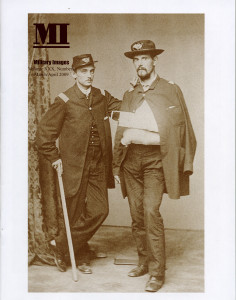The complete issue
Vol. XXX, No. 5
(40 pages)
Print edition: Visit our store to check availability
Digital edition: Visit JSTOR.org to purchase
Subscribe to MI
Explore the MI Archives: Browse | Advanced search | Tutorial
Inside
Cover image
A carte de visite from the Don Ryberg collection pictures Capt. Alexander A. McRoberts, left, and Capt. Charles W. Gibbs of the 44th New York Infantry. Both men were wounded in battle and show evidence of their injuries. McRoberts uses a cane to steady himself from a wound received at Gaines’ Mill, Va., on June 27, 1862. Gibbs, severely wounded at the Second Bull Run on Aug. 30, 1862, has his left arm bandaged and reinforced by a splint.
Inside Cover Image
A sixth-plate ambrotype from the David W. Vaughan collection is a portrait of an unknown Confederate sergeant. The photograph was obtained from a Virginia estate.
Table of Contents (p. 1)
Editor’s Desk, Front and Back cover details (p. 2)
The editor wishes everyone a Happy Holiday season.
Captain Jacob Voorhees, 58th Indiana Volunteer Infantry by Matthew Rector (pp. 3-7)
Jacob Everest Voorhees (1838-1907) is pictured in seven photographs that range from a portrait of him in civilian clothes made prior to his enlistment in 1861 to him in uniform to several post-war photographs. Voorhees began his war service as a second lieutenant in Company E in November in 1861. Not long afterwards, he was detached to serve in the Pioneer Brigade of the Army of the Cumberland. He served in this capacity at the Battle of Stones River, where members of the brigade repulsed numerous Confederate assaults. Voorhees survived the fight and the rest of the war. He mustered out as a captain in November 1864.
Inside the Sutler’s Tent (pp. 8-9)
An unusual carte de visite from the Matthew Rector collection features five men inside a sutler’s tent. One of the gents is Abraham P. Voorhees, a Terre Haute, Ind., merchant and the father of Jacob Voorhees of the 58th Indiana Infantry.
Confederate Images from the Collection of Domenick Serrano (pp. 10-17)
Eight ambrotypes and tintypes of Southerners in gray include one identified soldier, James Buchannon McCutchan of the 5th Virginia Infantry. He was wounded in the head at Chancellorsville on May 3, 1863, and was captured at Morton’s Ford, Va., on Feb. 7, 1864. He was sent to Fort Delaware and released on June 12, 1865.
William A. Hammond, Surgeon General, United States Army (pp. 18-19)
A quarter-plate daguerreotype by the studio of Mathew Brady is a portrait of Asst. Surg. Hammond shortly after he entered the U.S. army in June 1849. The image is part of the collection of Jules Martino. A brief sketch of his Civil War service accompanied by a wartime portrait is included.
Captain Gabe Alexander 2nd Kentucky Cavalry, C.S.A. by John Sickles (p. 20)
In the autumn of 1862, noted Confederate Col. John Hunt Morgan recruited Alexander, who became captain and commander of Company H of the 2nd. The company was detached to stay in Kentucky and ride south to divert Union troopers while Morgan embarked on his infamous raids of 1863. Alexander eventually joined the notorious raider Sur Mundy, and died in late July 1863 after being shot in the head by federals of the 12th Ohio Cavalry.
Soldier Poets in Gray by John Sickles (pp. 21-24)
Three poems include “Toast of Morgan’s Men” by Capt. Patrick Henry Thorpe of the 2nd Kentucky Cavalry, “The Letter That Came Too Late” by Col. William S. Hawkins of the 11th battalion Tennessee Cavalry and “Morgan’s War Song” by Brig. Gen. Basil Duke. The trio of poems are illustrated with wartime cartes de visite from the author’s collection.
Uniforms & History by Michael J. McAfee (pp. 25-30)
In “Army Chaplains,” McAfee describes the origins of the plain uniform worn by Union men of the cloth and illustrates the text with 11 portraits. The identified images include Thomas Mooney of the 69th New York State Militia, Sullivan Weston of the 7th New York State Militia, Augustus Woodbury of the 1st Rhode Island Infantry, John Pierpont of the 22nd Massachusetts Infantry, John Harvey of the 62nd New York Infantry, Edward Lord of the 110th New York Infantry, Peter Franklin Jones of the 1st New York Infantry, Lyman Bliss of the 51st New York Infantry and Louis Napoleon Boudrye (also spelled Beaudry) of the 5th New York Cavalry.
The Confederate Soldier (p. 31)
A hard plate image from the David W. Vaughan pictures a young volunteer armed with a musket and revolver and wearing a Corsican cap.
Stragglers (pp. 32-37)
Eight images—5 Union, 1 Confederate, 1 pre-war and 1 post-war—contributed by readers compose this issue’s collection. Included is an ambrotype believed to be Corp. Charles Davis Jr. of the 20th New York State Militia, a carte de visite believed to be noted poet and author Col. Charles G. Halpine, Pvt. John VanAkan (also known as VanAiken) of the 20th New York State Militia, E.M. Longbothan of the 11th Alabama Cavalry and Will Mosher Clark of the 65th New York Infantry.
Sutler’s Row (p. 38)
The Last Shot (p. 39)
A Union trooper grips his cavalry saber and is armed with what appear to be a pair of Starr Arms Co. Single Action 1858 Army revolvers. The hard plate image is part of the Marty Schoenfeld collection.
Inside Back Cover
A quarter-plate tintype from the Steven Karnes collection features a Wisconsin soldier armed with a converted Model 1816 musket and a pocket bible.
Back Cover
A carte de visite from the Karl Sundstrom collection shows Confederate guerilla leader Champ Ferguson and his Michigan guards. Ferguson was later convicted of war crimes and hung. His likeness was featured on the front cover of MI, Volume XXX, Number 4.



































